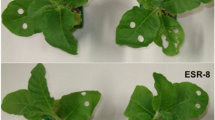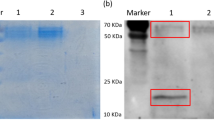Summary
In order to study possible functions of the inclusion body matrix protein (IBMP) encoded by gene VI of cauliflower mosaic virus (CaMV), the XbaI fragment containing the gene VI of a Japanese strain of CaMV (CaMV S-Japan) was transferred to tobacco plants by Ti mediated transformation. Eight out of 18 kanamycin resistant plants (40%) expressed detectable levels of IBMP. Those transgenic plants expressing IBMP produced leaves with light green color, and their growth was suppressed as compared with control plants. Symptom-like necrotic spots also appeared on the leaves and stems of the mature transgenic plants. Furthermore, in these transgenic plants, pathogenesis-related proteins 1a, 1b and 1c were highly expressed and the activity of 1,3-β-glucanase was increased up to eightfold. From these results, we concluded that expression of the IBMP is associated with symptom development.
Similar content being viewed by others
References
An G (1986) Development of plant promoter expression vectors and their use for analysis of differential activity of nopaline synthase promoter in transformed tobacco cells. Plant Physiol 81:86–91
Balazs E, Guilley H, Jonard G, Richards K (1982) Nucleotide sequence of DNA from an altered-virulence isolate D/H of the cauliflower mosaic virus. Gene 19:239–249
Baughman GA, Jacobs JD, Howell SH (1988) Cauliflower mosaic virus gene VI produces a symptomatic phenotype in transgenic tobacco plants. Proc Natl Acad Sci USA 85:733–737
Bradford MM (1976) A rapid and sensitive method for the quantitation of microgram quantities of protein utilizing the principle of protein-dye binding. Anal Biochem 72:248–254
Covey SN, Hull R (1981) Transcription of cauliflower mosaic virus DNA. Detection of transcripts, properties, and location of the gene encoding the virus inclusion body protein. Virology 111:463–474
Daubert S, Richins R, Shepherd RJ, Gardner RC (1982) Mapping of the coat protein gene of cauliflower mosaic virus by its expression in a prokaryotic system. Virology 122:444–449
Daubert S, Shepherd RJ, Gardner RC (1983) Insertional mutagenesis of the cauliflower mosaic virus genome. Gene 25:201–208
Daubert S, Schoelz JE, Debao L, Shephard RJ (1984) Expression of disease symptoms in cauliflower mosaic virus genomic hybrids. J Mol Appl Genet 2:537–547
Dixon LK, Hohn T (1984) Initiation of translation of the cauliflower mosaic virus genome from a polycistronic mRNA: evidence from deletion mutagenesis. EMBO J 3:2731–2736
Dixon LK, Koenig I, Hohn T (1983) Mutagenesis of cauliflower mosaic virus. Gene 25:189–199
Franck A, Guilley H, Jonard G, Richards K, Hirth L (1980) Nucleotide sequence of cauliflower mosaic virus DNA. Cell 21:285–294
Gardner RC, Howarth AJ, Hahn P, Brown-Luedi M, Shepherd RJ, Messing J (1981) The complete nucleotide sequence of an infectious clone of cauliflower mosaic virus by M13mp7 shotgun sequencing. Nucleic Acids Res 9:2871–2888
Giband M, Mesnard JM, Lebeurier G (1986) The gene III product (P15) of cauliflower mosaic virus is a DNA-binding protein while an immunologically related P11 polypeptide is associated with virions. EMBO J 5:2433–2438
Givord L, Xiong C, Giband M, Koenig I, Hohn T, Lebeurier G, Hirth L (1984) A second cauliflower mosaic virus gene product influences the structure of the viral inclusion body. EMBO J 3:1423–1427
Goldberg KB, Young MJ, Schoelz JE, Kiernan JM, Shepherd RJ (1988) Single gene of CaMV induces disease. Phytopathology 77:1704
Gordon K, Pfeiffer P, Futterer J, Hohn T (1988) In vitro expression of cauliflower mosaic virus genes. EMBO J 7:309–317
Hills GJ, Campbell RN (1968) Morphology of broccoli necrotic yellows virus. J Ultrastruct Res 24:134–144
Hirochika H, Takatsuji H, Ubasawa A, Ikeda, J-E (1985) Site-specific deletion in cauliflower mosaic virus DNA: possible involvement of RNA splicing and reverse transcription. EMBO J 4:1673–1680
Hirth L (1986) The molecular biology of caulimoviruses. Microbiol Sci 3:260–265
Hoekema A, Hirsch PR, Hooykaas PJJ, Schilperoort RA (1983) A binary plant vector strategy based on separation of vir-and T-region of the Agrobacterium tumefaciens Ti-plasmid. Nature 303:179–180
Hohn T, Richards K, Lebeurier G (1982) Cauliflower mosaic virus on its way to becoming a useful plant vector. Curr Top Microbiol Immunol 96:194–236
Hohn T, Hohn B, Pfeiffer P (1985) Reverse transcription in CaMV. Trends Biochem Sci 10:205–209
Howell SH (1982) Plant molecular vehicles: Potential vectors for introducing foreign DNA into plants. Annu Rev Plant Physiol 33:609–650
Kauffmann S, Legrand M, Geoffroy P, Fritig B (1987) Biological function of ‘pathogenesis-related’ proteins: four PR proteins of tobacco have 1,3-β-glucanase activity. EMBO J 6:3209–3212
Koenig R (1981) Indirect ELISA methods for the broad specificity detection of plant viruses. J Gen Virol 55:53–62
Laemmli UK (1970) Cleavage of structural proteins during the assembly of the head of bacterial phage T4. Nature 227: 680–685
Legrand M, Kauffmann S, Geoffroy P, Fritig B (1987) Biological function of pathogenesis-related proteins: Four tobacco pathogenesis-related proteins are chitinases. Proc Natl Acad Sci USA 84:6750–6754
Martinez-Izquierdo JA, Hohn T (1987) Cauliflower mosaic virus coat protein is phosphorylated in vitro by a virion-associated protein kinase. Proc Natl Acad Sci USA 84:1824–1828
Martinez-Izquierdo JA, Futterer J, Hohn T (1987) Protein encoded by ORF I of cauliflower mosaic virus is part of the viral inclusion body. Virology 160:527–530
Mazzolini L, Bonneville JM, Volovitch M, Magazin M, Yot P (1985) Strand-specific viral DNA synthesis in purified viroplasms isolated from turnip leaves infected with cauliflower mosaic virus. Virology 145:293–303
Menissier J, Laquel P, Lebeurier G, Hirth L (1984) A DNA polymerase activity is associated with cauliflower mosaic virus. Nucleic Acids Res 12:8769–8778
Modjtahedi N, Volovitch M, Sossountzov L, Habricot Y, Bonneville JM, Yot P (1984) Cauliflower mosaic virus-induced viroplasms support viral DNA synthesis in a cell-free system. Virology 133:289–300
Morrissey JH (1981) Silver stain for proteins in polyacrylamide gels: A modified procedure with enhanced uniform sensitivity. Anal Biochem 117:307–310
Murashige T, Skoog F (1962) A revised medium for rapid growth and bioassay with tobacco tissue cultures. Physiol Plant 15:473–497
Odell JT, Howell SH (1980) The identification, mapping, and characterization of mRNA for P66, a cauliflower mosaic viruscoded protein. Virology 102:349–359
Ohashi Y, Matsuoka M (1985) Synthesis of stress proteins in tobacco leaves. Plant Cell Physiol 26:473–480
Pfeiffer M, Laquel P, Hohn T (1984) Cauliflower mosaic virus replication complexes: characterization of the associated enzymes and of the polarity of the DNA synthesized in vitro. Plant Mol Biol 3:261–270
Schoelz JE, Shepherd RJ (1988) Host range control of cauliflower mosaic virus. Virology 162:30–37
Schoelz JE, Shepherd RJ, Daubert S (1986) Region VI of cauliflower mosaic virus encodes a host range determinant. Mol Cell Biol 6:2632–2637
Shepherd RJ (1979) DNA plant viruses. Annu Rev Plant Physiol 30:405–423
Shewmaker CK, Caton JR, Houck CM, Gardner RC (1985) Transcription of cauliflower mosaic virus integrated into plant genomes. Virology 140:281–288
Takatsuji H, Hirochika H, Fukushi T, Ikeda J-E (1986) Expression of cauliflower mosaic virus reverse transcriptase in yeast. Nature 319:240–243
Toh H, Hayashida H, Miyata T (1983) Sequence homology between retroviral reverse transcriptase and putative polymerases of hepatitis B virus and cauliflower mosaic virus. Nature 305:827–829
Towbin H, Staehlin T, Gordon J (1979) Electrophoretic transfer of proteins from polyacrylamide gels to nitrocellulose sheets: Procedure and some applications. Proc Natl Acad Sci USA 76:4350–4354
van Loon LC (1985) Pathogenesis-related proteins. Plant Mol Biol 4:111–116
Volovitch M, Modjtahedi N, Yot P, Brun G (1984) RNA-dependent DNA polymerase activity in cauliflower mosaic virus-infected plant leaves. EMBO J 3:309–314
Woolston CJ, Covey SN, Penswick JR, Davies JW (1983) Aphid transmission and a polypeptide are specified by a defined region of the cauliflower mosaic virus genome. Gene 23:15–23
Xiong C, Muller S, Lebeurier G, Hirth L (1982) Identification by immuno-precipitation of cauliflower mosaic virus in vitro major translation product with a specific serum against viroplasm protein. EMBO J 1:971–976
Young M, Shewmaker CK, Daubert S, Shepherd RJ (1987) Expression of cauliflower mosaic virus proteins from an integrated form of the viral genome. J Gen Virol 68:3217–3222
Author information
Authors and Affiliations
Additional information
Communicated by J. Schell
Rights and permissions
About this article
Cite this article
Takahashi, H., Shimamoto, K. & Ehara, Y. Cauliflower mosaic virus gene VI causes growth suppression, development of necrotic spots and expression of defence-related genes in transgenic tobacco plants. Mol Gen Genet 216, 188–194 (1989). https://doi.org/10.1007/BF00334355
Received:
Issue Date:
DOI: https://doi.org/10.1007/BF00334355




